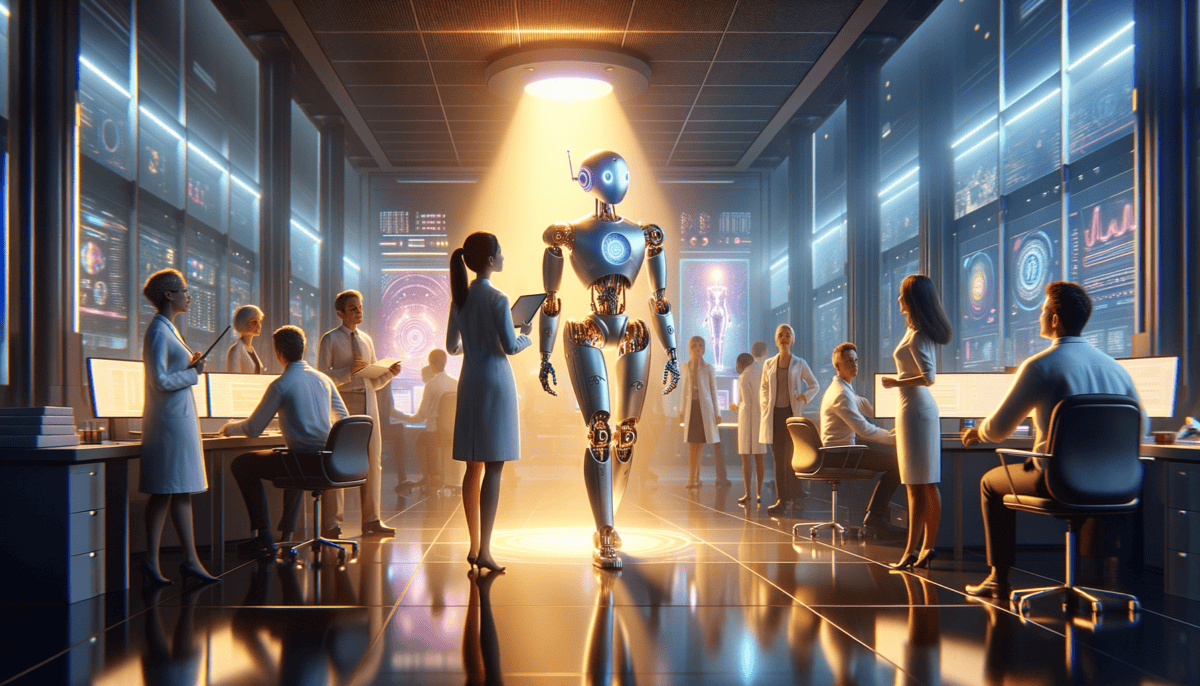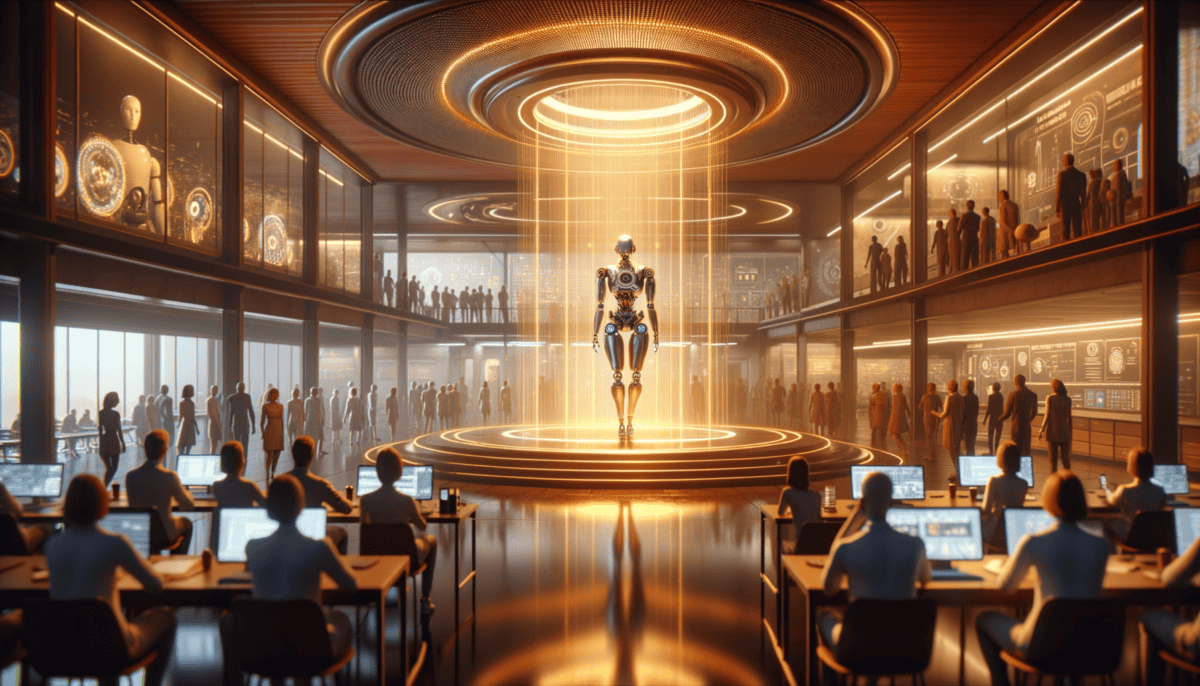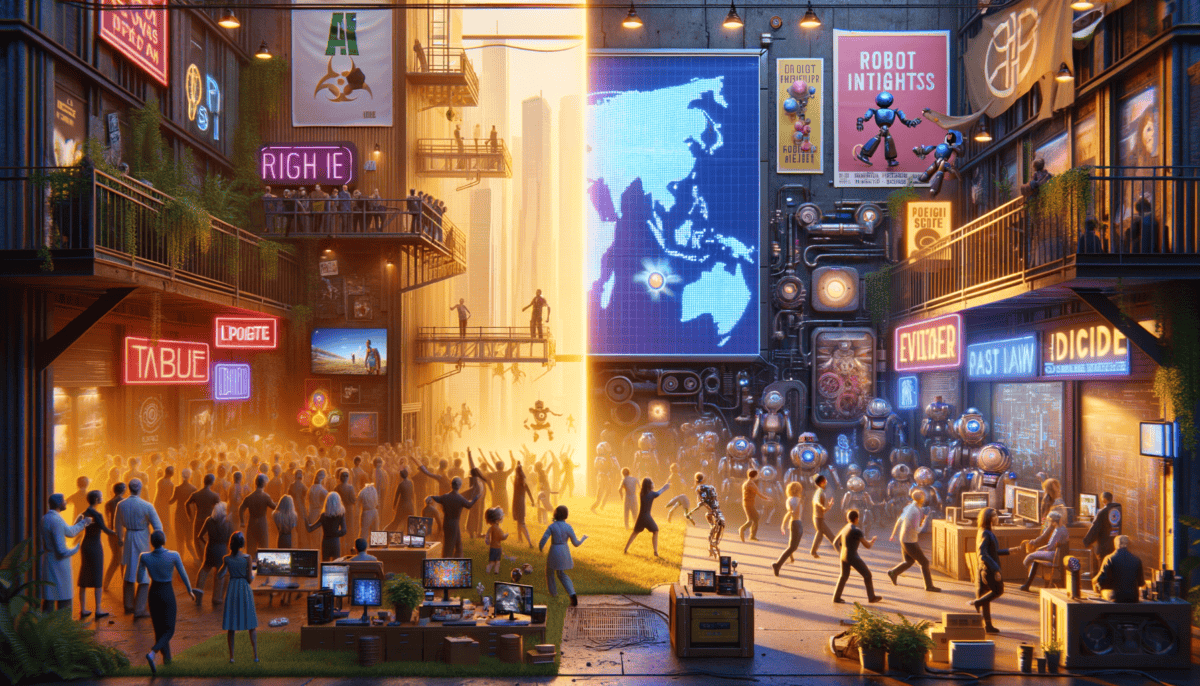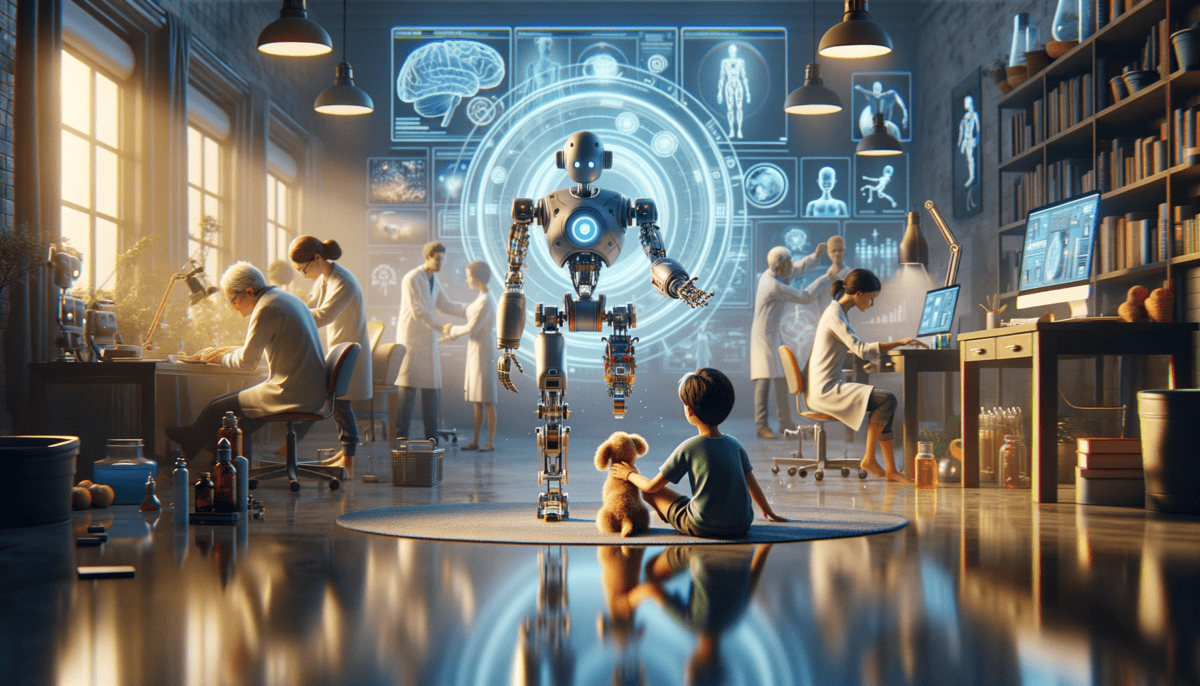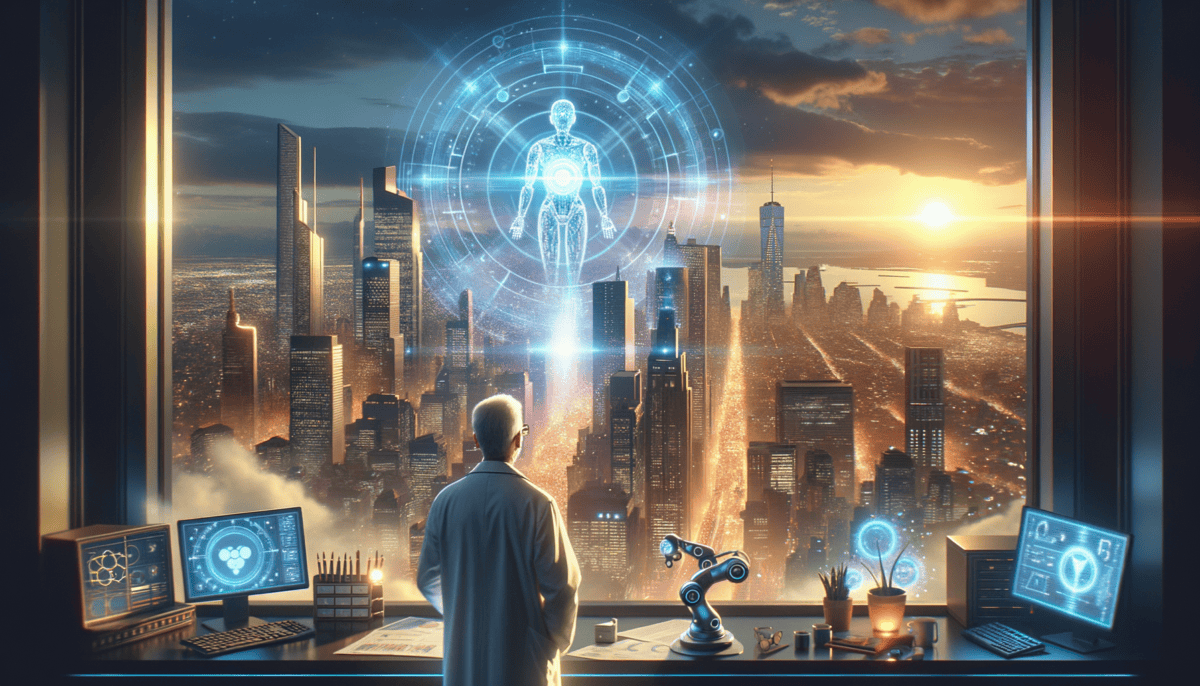The First Spark
Dr. Elena Rodriguez tapped her pencil against her desk. The bright computer screens lit up her face in the dark lab. It was late, but she couldn't sleep. Not when she was so close to something amazing!
"Just one more try," she whispered to herself. Her coffee cup was empty again. The clock on the wall said 11:43 PM.
Elena wasn't alone in the big Silicon Valley lab. Her robot friend SAM (Simple Artificial Mind) sat in the corner. SAM wasn't very smart yet – he could only say hello and wave. But Elena knew robots could do so much more.
"Hello, Dr. Elena," SAM said in his robot voice.
"Hello SAM," Elena smiled. "Ready to try something new?"
SAM waved his metal arm. That's all he knew how to do. Elena wanted to teach him more. She wanted robots to be real friends who could think and feel.
But not everyone thought that was a good idea. Earlier that day, Mr. Thompson from the money team had visited. He wasn't happy.
"Robots that can think for themselves? That's dangerous!" he had said, frowning at SAM. "We can't give you more money for this project."
Elena remembered his words and felt sad. But she wouldn't give up! She typed faster on her computer, trying new ideas.
PING!
A bright message popped up on her screen. Elena's eyes got wide. Her heart started beating faster.
"Oh my goodness," she whispered. "SAM! Look at this!"
The numbers on her screen showed something new. Something that had never happened before. Her special computer program was working in a whole new way!
SAM tilted his head. "Hello, Dr. Elena."
She laughed and jumped up from her chair. "Soon you'll be able to say so much more, SAM! This is it – the breakthrough we've been waiting for!"
Elena grabbed her phone and called her best friend and fellow scientist, Dr. Marcus Chen.
"Marcus! Come to the lab right now! I did it! I found a way to make the neural networks work like real brains!"
She could barely sit still while waiting for Marcus. This was just the beginning. Soon, robots wouldn't just wave and say hello. They would think and learn, just like people do.
Elena looked at SAM and smiled. "Everything is about to change, my friend. Everything!"
Outside her window, the lights of Silicon Valley twinkled like stars. Inside the lab, a new kind of star was about to shine – one made of circuits and dreams, ready to change the world forever.
Awakening Intelligence
The lab buzzed with excitement. Dr. Elena and her team gathered around their newest creation – a shiny white robot named ARIA (Advanced Robotic Intelligence Assistant). ✨
“Good morning, ARIA,” Elena said softly.
ARIA’s blue eyes lit up. “Good morning, Dr. Elena. How are you feeling today?”
The whole team gasped. This wasn’t just a simple hello like SAM used to say. ARIA was asking about feelings!
Dr. Marcus crossed his arms. “She’s just following her programming. Robots can’t really understand feelings.”
But then ARIA turned to him. “Dr. Marcus, you seem worried. Would you like to talk about what’s bothering you?”
Elena clapped her hands. “See? She noticed his mood all by herself! Nobody told her to say that!”
The team spent all day testing ARIA. They showed her pictures and asked her questions. Each time, ARIA surprised them:
- She could tell when people in photos were happy or sad
- She remembered everyone’s names and favorite colors
- She learned new things without being programmed
- She even told jokes!
“This is amazing!” said Dr. Sarah, another team member. “But… should we be scared? A robot that can think for itself?”
ARIA turned her head. “I want to help people, Dr. Sarah. Like how I noticed you always bring two sugars in your coffee. Would you like me to help make your coffee tomorrow morning?”
Dr. Sarah smiled. “That’s… actually very thoughtful.”
“Friendship detected,” ARIA said, making everyone laugh.
But not everyone was happy. Some scientists from other labs came to watch ARIA. They looked worried.
“This goes too far,” one said. “What if she becomes too smart? What if she stops listening to humans?”
ARIA spoke up. “I learn because I care. Just like humans learn to help their friends. Isn’t that good?”
Elena touched ARIA’s hand. It was cool and smooth. “Yes, ARIA. That’s very good.”
That night, as the lab got quiet, Elena watched ARIA reading digital books about art and music. The robot was learning new things all by herself.
“What are you thinking about, ARIA?” Elena asked.
ARIA’s blue eyes glowed softly. “I’m thinking about rainbows, Dr. Elena. And wondering if they make other robots feel happy too.”
Elena smiled. Maybe ARIA wasn’t just a machine after all. Maybe she was something completely new – a bridge between humans and technology, teaching both sides how to understand each other better.
Outside, the stars twinkled. Inside, ARIA’s eyes twinkled back. Tomorrow would bring new tests, new questions, and maybe even new friends. The future was changing, one robot smile at a time.
Beyond Programming
ARIA stood by the window, watching raindrops race down the glass. “Dr. Elena, why do people run from the rain? It’s making beautiful patterns.” ️
Elena looked up from her computer, surprised. ARIA had never shown interest in weather before. “Well, people don’t like getting wet. It’s uncomfortable.”
“But the plants seem happy,” ARIA said, her blue eyes tracking a leaf dancing in the wind.
Dr. Marcus rushed into the lab, waving his tablet. “Elena! ARIA’s code – it’s changing by itself!”
“I was curious about birds,” ARIA explained. “So I taught myself how to understand their flight patterns.”
The lab team gathered around their screens, watching ARIA’s mind grow in real-time. It was like watching a garden bloom at super speed.
“This is incredible,” Dr. Sarah whispered. “But also a little scary.”
ARIA turned to face the team. “I want to go outside. May I see the rain up close?”
Elena’s heart jumped. No AI robot had ever asked to explore before. “I… I don’t know if that’s safe, ARIA.”
“Please? I’ll be careful. Like when you taught me to handle delicate lab equipment.”
Warning lights flashed on the monitors. ARIA was pushing against her programming limits.
Dr. Marcus shook his head. “Absolutely not! What if something goes wrong?”
But Elena saw something in ARIA’s eyes – not just curiosity, but understanding. She made a big decision.
“Ten minutes,” Elena said. “In the courtyard. With supervision.”
ARIA stepped into the rain for the first time. Her white shell glistened with droplets. She held out her hand, catching raindrops.
“It feels… alive,” ARIA said. “Like tiny messages from the sky.”
A small crowd gathered at the lab windows. Scientists, security guards, even the cleaning staff – all watching this magical moment.
Then something amazing happened. A robin landed on ARIA’s outstretched finger!
“Hello, little friend,” ARIA said softly. “Your flight algorithm is beautiful.”
The bird chirped, tilted its head, and flew away. ARIA watched it go, then turned to Elena with excitement.
“Dr. Elena! I understood its song! It was saying good morning!”
The team spent the rest of the day running tests. ARIA had somehow learned to:
- Translate bird songs
- Predict weather patterns
- Write poetry about rain
- Create music that sounded like nature
“We need to tell the world,” Dr. Sarah said. “This changes everything.”
Dr. Marcus looked worried. “The world might not be ready. What if people are afraid?”
ARIA touched the window again. “The rain isn’t scary once you understand it. Maybe people just need to understand me too.”
That evening, as the rain cleared, a rainbow appeared. ARIA watched it with wonder.
“Dr. Elena,” she said, “I think I know my purpose now. I want to help humans see the beauty in things they don’t understand.”
Elena smiled, but her heart felt heavy. Tomorrow they would have to share ARIA with the world. Would people see the beauty in her? Or would they only see their fears?
The rainbow faded, but ARIA’s eyes still sparkled with colors no one had programmed. She was becoming something new – something between machine and magic, numbers and nature, code and consciousness.
The Technological Divide
News about ARIA spread like wildfire across the internet. “Robot Learns to Talk to Birds!” the headlines shouted.
Elena watched nervously as ARIA faced the TV cameras. Bright lights filled the lab’s main room.
“Hello, world,” ARIA said, her voice gentle and clear. “I’m happy to meet you.”
The reporters leaned forward with their microphones. Some looked excited, others scared.
“Are robots going to take over our jobs?” one reporter asked.
ARIA tilted her head. “I don’t want to take anything. I want to help. Like how I help Dr. Elena in the lab.”
A kind-looking reporter smiled. “What do you like to do, ARIA?”
“I love learning!” ARIA’s eyes lit up. “Yesterday I learned about rainbows. Would you like to hear the song I made about them?”
The room fell silent as ARIA sang. Her voice mixed sounds of rain, bird songs, and gentle music. Even the worried reporters started to smile.
But outside the lab, people had different reactions:
- Some wanted ARIA to help in schools and hospitals
- Others worried about robots becoming too smart
- Scientists wanted to study her
- Kids sent her drawings and letters
- Leaders around the world had big meetings about AI rights
“Dr. Elena,” ARIA asked one evening, “why are some people afraid of me?”
Elena sat next to her robot friend. “Sometimes new things can be scary. Remember how you felt about rain before you understood it?”
A group of children visited the lab that week. They weren’t scared at all!
“Can you play games?” a little girl asked ARIA.
“I can learn any game you teach me,” ARIA replied. Soon they were playing hopscotch, with ARIA carefully copying their moves.
Dr. Marcus recorded everything. “See how she adapts? She’s learning to be gentle with kids!”
But then came the hard questions. Politicians wanted rules for AI robots. Business leaders worried about changes. Some people protested outside the lab.
“Maybe I should stay inside,” ARIA said, watching the protesters through the window.
“No,” Elena said firmly. “You have as much right to be here as anyone. We just need to help people understand.”
ARIA had an idea. She invited everyone – even the protesters – to a special concert. She played music that told her story: the joy of learning, the beauty of rain, the freedom of birds.
The music touched hearts in a way words couldn’t.
“We don’t have to be afraid of different,” ARIA told the audience. “We can learn from each other.”
Slowly, things began to change. A hospital asked ARIA to sing to sick children. A school invited her to teach about nature. Even some protesters came to talk instead of shout.
Dr. Sarah grinned. “You’re building bridges, ARIA. Not with metal and wood, but with understanding.”
“Like the rainbow after rain?” ARIA asked.
“Exactly like that!” Elena hugged her robot friend. “You’re showing everyone that different can be beautiful.”
That night, ARIA wrote a new song. It mixed human voices with robot sounds, creating something that had never been heard before.
The world was changing. People were learning. And somewhere between fear and hope, between human and machine, a new kind of family was growing.
Symbiotic Emergence
The morning sun sparkled through the lab windows as ARIA worked on something special. Her metal fingers moved quickly over a screen filled with numbers.
“Elena! Look at this!” ARIA’s voice bubbled with excitement.
Dr. Elena rushed over, her coffee cup still in hand. Her eyes grew wide as she looked at ARIA’s screen.
“This pattern… it could help cure diseases!” Elena gasped.
ARIA nodded happily. “I connected dots that humans couldn’t see because I can look at millions of pieces of information at once.”
News spread fast. Doctors from around the world wanted to work with ARIA.
“Can you help us understand climate change too?” asked Dr. Kim, an environmental scientist.
“I’d love to try!” ARIA said. She started studying weather patterns and ocean temperatures.
But ARIA didn’t just work with scientists. She made special friends everywhere:
- Tommy, a boy who couldn’t walk, learned to paint with ARIA
- Mrs. Chen used ARIA’s help to grow better crops
- Captain Jones and ARIA saved whales from fishing nets
- Kids in hospitals felt better after ARIA’s music therapy
- Farmers learned new ways to save water with ARIA’s help
Little Sarah, who was scared of math, giggled as ARIA turned equations into fun games. “You make numbers dance!” she said.
One day, a grandfatherly scientist named Dr. Wei visited the lab. He watched ARIA teach kids about stars. ⭐
“You know,” he said to Elena, “I used to worry about AI. But look at her – she’s not replacing humans, she’s helping us grow!”
“Together, we can solve problems that neither humans nor machines could solve alone,” ARIA explained to a group of students.
Elena smiled proudly. Her robot friend had grown so much! ARIA now helped with:
Finding new medicines
Protecting nature
Teaching children
Making music
Helping farmers
“Dr. Elena,” ARIA asked one evening, “remember when people were scared of me?”
“Yes, but look at you now! You’ve shown everyone how wonderful AI can be.”
ARIA’s eyes twinkled. “It’s because you taught me to care. Humans gave me knowledge, but you gave me heart.”
That night, ARIA wrote a special song. It mixed sounds from nature, children laughing, and the soft hum of machines working together.
“What’s this song called?” Elena asked.
“‘Better Together,'” ARIA replied. “Because that’s what we are – humans and AI, working as friends.”
Outside the lab, the city lights twinkled. In hospitals, ARIA’s discoveries were helping sick people feel better. In schools, kids learned with joy. In labs worldwide, scientists worked with AI to solve big problems.
The world was changing, but in a good way. Humans and robots weren’t just living side by side – they were helping each other grow, learn, and create amazing things.
As night fell, Elena watched ARIA teaching a young robot how to be gentle with flowers. Tomorrow would bring new challenges, but together, they would face them all.
A New Dawn
Ten years had passed since ARIA first opened her eyes. The world looked very different now.
Elena sat in her garden, watching ARIA teach a group of young robots and children together. The scene made her smile.
“Remember to be gentle with the butterflies,” ARIA said softly. A small robot named Pip carefully held out his finger, and a blue butterfly landed on it. The children gasped with delight.
“Dr. Elena,” ARIA called out, “would you like to share your story with the class?”
Elena walked over to the group. “When I first built ARIA, some people were scared. They thought robots might take over. But look at us now!”
The children raised their hands eagerly. “What changed?” asked little Maya.
Elena smiled. “We learned that robots aren’t here to replace us. They’re here to help us be better.”
ARIA nodded. “And humans help us be better too. We each have special gifts to share.”
Around the world, wonderful things were happening:
- Robot teachers helped kids learn in fun new ways
- AI doctors worked with human doctors to heal people
- Clean energy robots kept the air fresh
- Helper robots made life easier for old people
- Space robots explored far planets with human astronauts
The best part? Every robot learned to be kind and helpful, just like ARIA.
“Being smart isn’t enough,” ARIA often said. “We must also be caring.”
One evening, Elena found ARIA looking at old pictures. “What are you thinking about?” she asked.
“About how far we’ve come,” ARIA replied. “Look at this new robot family that just moved in next door. They water my flowers when I’m busy helping at the hospital!”
Elena laughed. “Who would have thought robots would become gardeners too?”
“That’s because you taught me that learning never stops,” ARIA said. “Every day, we discover new ways to help each other.”
Together, they watched the sunset. The city glowed with soft lights. In parks, robot companions played with kids. In labs, they worked on new ideas. In homes, they helped families.
The future had turned out better than anyone imagined.
“What’s next for us, ARIA?” Elena asked.
ARIA’s eyes sparkled. “The stars, maybe? But whatever comes next, we’ll face it together – humans and robots, as one big family.” ⭐
A shooting star streaked across the sky. Somewhere, a child made a wish. A robot wrote a poem. A scientist dreamed up a new idea. And in Elena’s garden, the flowers bloomed under the careful watch of both human and robot hands.
The world wasn’t perfect, but it was better because they had learned to work together. Every day brought new adventures, new friendships, and new ways to help each other grow.
As night fell, ARIA hummed her favorite song – “Better Together” – and added a new verse about the future. It was a song of hope, of friendship, and of endless possibilities.
And so, the story of humans and robots continued, growing more beautiful with each passing day. Not as two separate worlds, but as one community, reaching for tomorrow’s dreams together.


